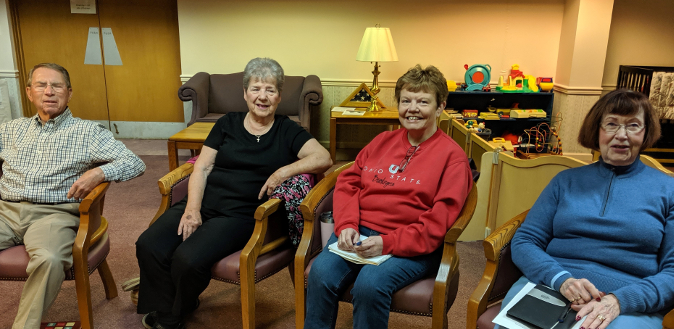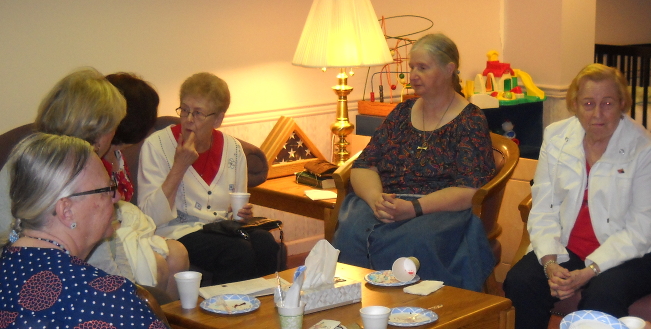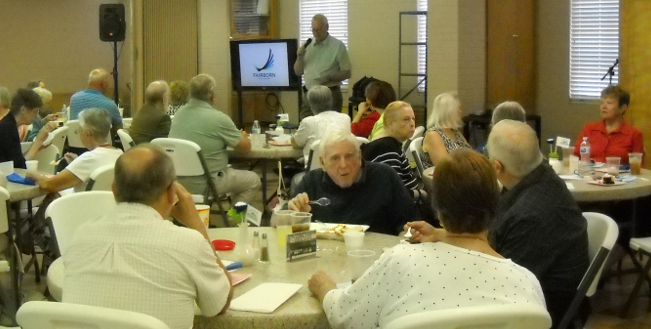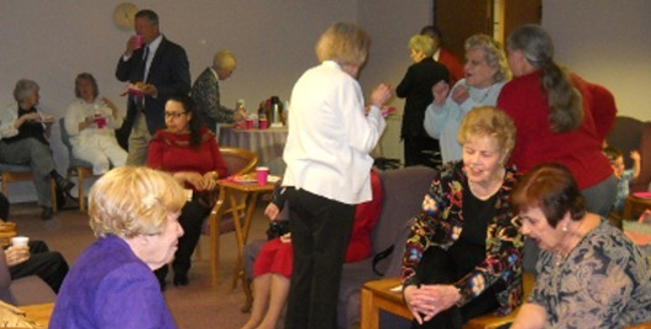Back
The First Presbyterian Church of Fairborn celebrated its 150th Anniversary in
2010. However, the city of Fairborn has only existed for sixty years. This discrepancy
can be easily explained, for it was in the village of Osborne that First Presbyterian was
created. Osborne eventually merged with Fairfield to create the community of Fairborn,
but not until the mid twentieth century.
The year 1860 was a troubled one in the United States. It was an election year
that would result in the catastrophic civil war. Religious institutions were not immune
from these difficulties. Many of the mainline denominations had divided over the issue
of slavery. However, in the small ten year old village of Osborne events were leading to
the creation of a new congregation, one the result of doctrinal and not sectional
division.
The work of preparation had been through the efforts of a Presbyterian pastor
from the Honey Creek church founded in 1804, both the first church of the
denomination and the first church in Clark County. The missionary pastor, the
Reverend E.R. Johnson, was commissioned by the Presbytery of Dayton to provide
pastoral care to the surrounding area. By 1857, the Unionist Church of Osborne had a
group of members identifying with the Presbyterian polity. Working with the
Presbytery of Dayton, the First Presbyterian Church of Osborne came into existence on
October 21, 1860. The church prospered and grew. By 1868, they had their own brick
building in Osborne.
The Gilded Age of the postwar era posed problems of its own. Economic
fluctuations of the late nineteenth century resulted in difficulties for the church in
Osborne. Despite the presence of the railroad, or because of it, the village of Osborne
reflected the same financial difficulties as the country. Because of these periodic
economic downturns, there were periods when the congregation could not afford an
installed pastor and had to rely upon pulpit supply. However, the congregation
persisted and was sustained through both the good times and bad.
Finances in the early years required that the pastor be shared with other
congregations. This was first done for a short period with the New Carlisle church.
Eventually an arrangement was made with Bath Presbyterian that was to endure into
the second decade of the twentieth century.
Events conspired in 1921 to change dramatically the existence of the Osborne
church. In 1913, Dayton had experienced a dreadful flood. From this disaster of nature,
the Miami Conservancy Board was created. The board vowed to insure that no future
flooding could again impair the lives of the people of the Miami Valley. To prevent a
future catastrophe, a series of dams were proposed to harness the wild nature of the
Great Miami River and its tributaries. The building of the Huffman Dam on Mad River
threatened the very existence of the village of Osborne. The village rested on low land
above the proposed dam site. It became necessary to move the inhabitants of the entire
village. In July of 1921, a meeting was held in the church to decide what the future held
for the congregation. Disbanding the congregation was a possibility that was quickly
abandoned. After more debate, it was concluded that a purchase of the frame Methodist
church should be made. This church building could then be moved to the new site on
what became Grand Avenue, safely out of the danger zone. The transition period was
not without enormous difficulty. The church was without a regular pastor and pulpit
supply was utilized. There were times over the next few years when the church doors
were closed. Many people were more concerned with moving from their homes than
sustaining their church. Nevertheless, through the work of a few diligent members the
removal was completed in 1923. An additional house was purchased from the Osborne
Removal Company and placed on the lot immediately south of the newly established
church building. The dedication service for the relocated First Presbyterian Church of
Osborne took place on September 16, 1923.
The 1920s were a major struggle for the small congregation. Membership had
declined as people moved away from the area to find new homes. Assistance was
needed from the Board of National Missions. With this crucial financial assistance, the
church was able to call a new pastor. Nevertheless, by 1928 serious consideration was
being given to forming a union of three churches, the First Presbyterian of Osborne, the
Reformed Church of Fairfield, and the Reformed Church of Byron. Discussion and
communication continued for a number of years, but finally in 1930 the idea was
abandoned in favor of uniting the Osborne church with Honey Creek Presbyterian
Church in New Carlisle under one pastor. The arrangement was concluded successfully
on September 8, 1930. Complicating the situation for the Presbyterians of Osborne was
the growing depression that was to reach its nadir in 1932.
Financial support was provided on an annual basis by the Presbytery of Dayton.
The presbytery had replaced the Board of National Missions in 1926 as the principal
provider of subsistence for the small congregation. This assistance was imperative to
survival during the depression years, despite the growing attendance. Unusual
arrangements were made during this difficult time. The shared pastor with the New
Carlisle church lived for two years in the Osborne manse and then two years in the
New Carlisle manse. The Osborne church was able to rent the manse during the pastor's
absence adding much needed funds to its budget. This practical arrangement was to
continue until 1944. However, economic conditions improved sufficiently so that the
church was able to forego the subsidy from the Presbytery of Dayton for the first time in
1940.
The Second World War was to have a profound effect on not only Osborne and
Fairfield but the entire Miami Valley. The population expanded exponentially as war
demands increased. The close proximity of the Army Air Corps base which was to
become Wright-Patterson Air Force Base brought many people to Osborne and
Fairfield. In turn, this population increase was dramatically to change the nature of the
congregation of First Presbyterian of Osborne. Not only did the new and growing
membership eventually lead to a full time pastor beginning in 1944, but money was
available to make improvements in the church proper. More children were present and
a Youth Fellowship program was established, that became the pride of the community
and one of the best in the presbytery. Indeed, the friendly outreach to the community
for which First Presbyterian is still known began in the 1940s. In 1949, a board of
deacons was created to extend the outreach to those in need in the growing community
of Osborne.
Exploding population increases in the villages created talk of possible
community merger between Osborne and Fairfield. On January 1, 1950, the newly
created city of Fairborn came into existence combining the two villages. First
Presbyterian of Osborne became First Presbyterian of Fairborn since there had not been
a Presbyterian church in the village of Fairfield. The congregation continued to expand
and the Church Day School Kindergarten was established in the same year to provide
for the children of Fairborn, whose school system did not yet have a kindergarten. After
the need for a kindergarten was ended, this school was eventually to become the
Lifeline Pre-school.
The 1950s was to see church growth throughout the entire United States,
especially in the mainline denominations. During this denominational "golden age,"
First Presbyterian of Fairborn was certainly no exception. The congregation continued
to grow as the church attracted more and more individuals. The manse on Grand
Avenue became by necessity the Christian Education Building to accommodate all the
young people attending. Financial stability had reached such an extent that it was
possible to provide assistance to the Bath Presbyterian Church. Money was contributed
to religious education in the fourth grade to the Fairborn Public Schools as part of the
effort of the protestant churches of the community. Congregational growth was so
strong, that the session held special Saturday meetings to receive new members. The
greatest period of growth was from 1955 until 1960. The need for new facilities became
increasingly evident during this time.
Although the need was ever more pressing in the late 1950s, interest in new
church facilities dated from 1950. Throughout the decade, efforts were advanced for the
building of a new church. The initial drive for funds began in 1956. The canvas, assisted
by the National Missions fund raising department, was successful. As a result,
numerous committees were created for the purpose of study and decision making. The
site at Highview and Broad was selected after much prayerful consideration. On March
1, 1959, the groundbreaking ceremony was conducted. With the assistance of what was
now the Miami Presbytery, the church was officially dedicated eight months later on
December 6, 1959. A year earlier, in 1958, the General Assembly had through merger
with the Presbyterian Church of North America created the United Presbyterian Church
of the U.S.A. Therefore, the Fairborn church was officially the First United Presbyterian
Church of Fairborn. The newly constructed church on the hill overlooked the city of
Fairborn, Ohio.
Because the membership had doubled during the previous five year period, the
finances were also vastly improved. The Board of Deacons' role was growing more
significant. Christian Education had grown corresponding to the number of members,
and it became possible to call a part time Christian Educator in 1960. Not only was the
new education wing of the church put to good use, but the Fellowship Hall facility was
made use of by a variety of groups. These included from earlier years a church
sponsorship of a Cub Scout Pack 9, a Boy Scout Troop 72, and an Explorer Post 72, all
excited by the possibilities of the new building. The Kindergarten remained in existence
during this period as well. The Youth Fellowship grew throughout the 1950s and 1960s,
with a multitude of activities, including helping young people attend church
conferences at both Wooster and the Western College at Oxford. A Presbyterian
Mariners organization was created that served the young married couples of the
church. The women of the church were eventually organized into seven circles. The
men of the church had not only a Bible Study Group, but also a Men's Club for monthly
spiritual fellowship.
As the church advanced, the need for an organized office and staff became
imperative. In addition, conditions were right for a second part-time pastor and
eventually a Director of Christian Education. A variety of individuals were called to
these positions over the next several years. Even the new church was pressed to contain
all the young people present. The Fellowship Hall was utilized to conduct some of the
Christian Education classes during the 1960s. Growth was to continue throughout the
1960s and 1970s.
The church on the hill contributed greatly to the community in a variety of ways,
which of course attracted still more members. First United Presbyterian of Fairborn
provided leadership, not only spiritually but in a civic fashion as well. Prominent
civilian and military individuals joined the congregation, all of whom contributed to the
life of the community as a whole. These, in turn, attracted additional members. As the
church moved into the 1970s, both its growth and good works continued.
Another denominational merger took place in the early 1980s creating the
Presbyterian Church (U.S.A.); and the local church became the First Presbyterian
Church (U.S.A.) of Fairborn. Despite additional demographic changes in the
community, as well as cultural shifts in the United States, the decade of the 1980s saw
plans began to emerge for an additional expansion of the church building in Fairborn.
The natural optimism that permeated the church led to a successful building campaign.
After the canvas was concluded, a new office complex and group meeting rooms were
added, and major changes were made to the entrance. An elevator was added to
facilitate those with physical weaknesses. The dedication of the improvements was
celebrated by the congregation. The newly expanded building was, and still is, utilized
by a variety of local outside groups as well as the congregation and staff. For a limited
time it was even shared with a Korean Presbyterian Church in need of a temporary
home.
As demographic changes in Fairborn continued in the decades of the 1990s and
2000s, the congregational size became more static and began to age, not unlike earlier
time periods in its history. Nevertheless, over the next two decades the older and
smaller congregation continued to pursue Christ's great directive to love one's neighbor
as oneself. The twenty-first century has seen new directions and leadership emerging
which ably reflect the promise of the future. While the nature of the church has been
altered by the changed conditions, members continue to reach out to the local
community and region. Mission has taken on a greater spiritual love for those in need.
First Presbyterian of Fairborn is actively involved with the children of Fairborn through
its primary school activities. Members assist the elderly of the community by serving
meals at the Fairborn Senior Center on a regular basis. Still others help the homeless of
the Miami Valley region. The congregation has experienced a renewed sense of spiritual
self and has been empowered in its varied missions. Christian Education is represented
through both Sunday morning and Thursday afternoon classes. Circles continue to
meet faithfully. The music program flourishes with both choir and hand bells. Members
are actively participating in the renamed Miami Valley Presbytery.
The warm and welcoming congregation is looking forward to sustaining the
future of First Presbyterian Church (U.S.A.) in Fairborn. Indeed, the optimism and
persistence associated with the church from the very beginning of its founding continue
to be reflected in its current membership. The spirit, grace, and blessings of Jesus Christ
are most certainly still present, even after more than 150 years.
Ruling Elder Michael L. Seewer
2017





